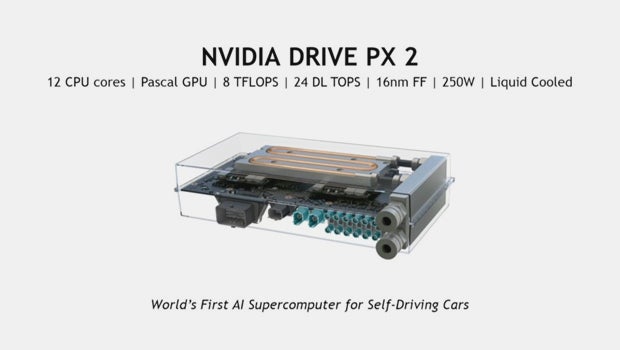Nvidia announces Drive PX2 supercomputer for self-driving cars

Nvidia has kicked off CES 2016 by announcing a new ‘supercomputer’ that it believes will power the next generation of self-driving cars.
The Nvidia Drive PX2 designed with ‘deep learning capabilities’ is a follow up to last year’s Drive PX computer, is the size of a small lunchbox and is cooled by liquid.
Nvidia is calling this the ”World’s First AI Supercomputer for Self-Driving Cars,” and the entire unit will be placed in the trunk of the vehicle.
It has 12 CPU cores, the Pascal GPU, 8 TFLOPS of performance offering “unprecedented amounts of processing power for deep learning,” equivalent to 150 MacBook pro laptops.
It will be used to run powerful software that, when combined with sensors and GPS, will improve perception abilities of self-driving vehicles. It’ll be used to tackle challenges like unexpected road debris, erratic drivers and construction on the road.
The deep learning abilities will also help to tackle problem areas like poor weather and lighting conditions.
Nvidia is already using a reference platform it is calling the Nvidia Drivenet, which has 9 inception layers that can perceive real world objects in real time.
Some systems are also being designed to recognise German road signs “better than a human can.”
See also: CES 2016: What to expect from this year’s show
According to Nvidia, the likes of BMW, Audi and Ford are using its systems to develop their own self-driving cars. The company is calling it an “end to end” loop that it hopes will help realise the dream of self-driving cars.
“Drivers deal with an infinitely complex world,” said Jen-Hsun Huang, co-founder and CEO, NVIDIA.
“NVIDIA’s GPU is central to advances in deep learning and supercomputing. We are leveraging these to create the brain of future autonomous vehicles that will be continuously alert, and eventually achieve superhuman levels of situational awareness. Autonomous cars will bring increased safety, new convenient mobility services and even beautiful urban designs — providing a powerful force for a better future.”
Some Developers will gain access to the platform midway through the year, while a developmental engine will be widely available by the end of the year.


